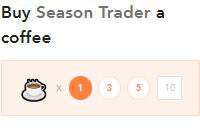Market Radar 06. December 2022
Market
The fear of one’s own courage
The SPY closed below the 400 mark on Monday. This is a clear warning: anyone who reacted euphorically on Friday to the will of the stock market to follow the trend and not the news saw on Monday that this will has now given way to the fear of one’s own courage.
The upper limit now seems too close
Perhaps some stock market participants also looked at the SPY in the annual chart at the weekend. December 1 can now be interpreted as a failed attempt to leave the upward downward trend that began on January 4 this year. The SPY is currently trading at the upper limit of this downtrend channel. In addition, the much-noticed 200 moving average is quoted at just over 400 points, i.e. about the upper limit of this channel.
Should the SPY stabilize above 390 points in the next few days, then the optimists might sense a bit of hope again. Currently, a consolidation between 400 and 390 points in the SPY would probably be the scenario that currently appears to be the best possible scenario for the friends of long trading.
A dynamic breakout above 400 points in the SPY this trading week would probably surprise even the strongest bulls in terms of charts.
If the SPY closes below 390 points, then the 380 points will be the first milestone for the bears. Presumably, the bears – once there – will really get going.
The QQQ receives the daily stamp “bottoming or sideways”, the IWM still “Buy the dip”. Both could still boast on Friday with the day stamp “Buy or top-up”.
The IPO ETF lost almost 5% yesterday. IPO now receives the day stamp “Wait and see or speculate on sell off” again. The hope of coming back into the buyable area soon should have almost completely disappeared after this Monday – this also applies to Cathy Wood’s Risk-On ETFs.
Get the Seasonal Tradingsignals on you cell phone
What do we see under the radar of the major stock indices?
Sell the banks
On Monday, we saw a classic sell signal at virtually all major US and regional banks. JPMorgan & Chase (JPM), Wells Fargo (WFC) and Bank of America (BAC) now probably offer more opportunities on the short side than on the long side. I am a little surprised that many regional banks also suffered from stop-loss avalanches. After all, many of them benefit from higher interest rates. Quite a few regional banks had formed cup-like formations by Friday, which now probably have to be broadened before it can come to a start to new highs.
Insurance companies (KIE) look much more stable than banks in the chart. But the possibility that the risk-on part banks will drag down the risk-off part insurance should now be taken into account.
Where could the trend not break?
The healthcare sector (XLV) continues to look constructive in terms of chart technology. Also, the utilities (XLU) usually look as if a trend continuation would be more likely than a trend break.
Stocks in the industrial and housing sectors, as well as REIT’s stocks, could also escape a trend break.
Special story oil and gas: was it now?
Oil and gas stocks were among the biggest losers on Monday. Similar to bank stocks, we can now see the trend break in oil and gas stocks. For a long time this year, oil stocks have risen when other stocks have fallen. This asymmetry in the price development should now be over for the time being.
Indonesia and India
Indonesia (EIDO) and Brazil (EWZ) have been upgraded again. Both country ETFs now receive the daily stamp “Buy the dip”. I would prefer Indonesia to Brazil, simply because EIDO was able to form a higher high on December 1, but EWZ did not.

